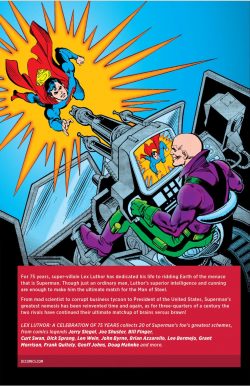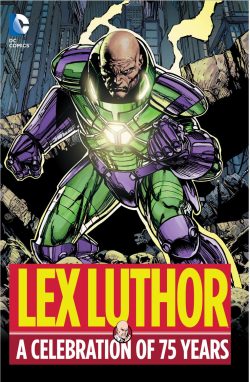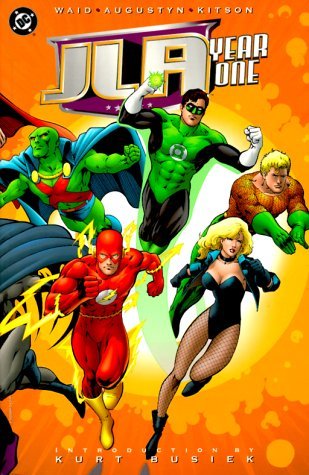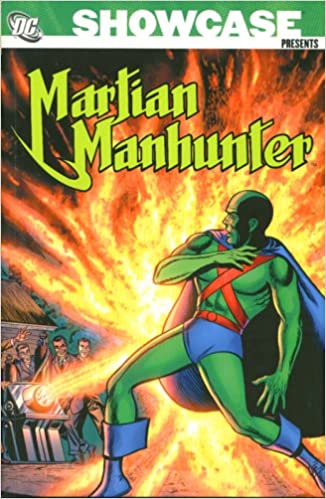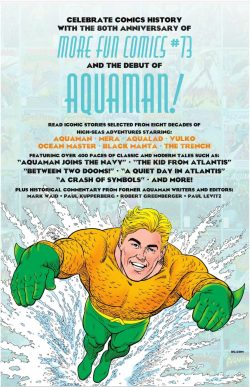
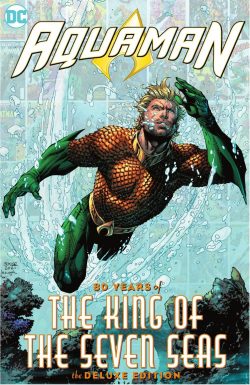
By Mort Weisinger & Paul Norris, Joe Samachson, Otto Binder, Robert Bernstein, Jack Miller, Bob Haney, Steve Skeates, Paul Levitz, Paul Kupperberg, J.M. DeMatteis, Neal Pozner, Keith Giffen & Robert Loren Fleming, Peter David, Jeph Loeb, Will Pfeifer, G. Willow Wilson & Tony Bedard, Geoff Johns, Dan Abnett, Louis Cazeneuve, John Daly, Ramona Fradon, Nick Cardy, Jim Aparo, Mike Grell, Don Newton, Dick Giordano, Craig Hamilton, Curt Swan, Martin Egeland, Jim Calafiore, Ron Garney, Patrick Gleason, Joshua Middleton, Ivan Reis, Stjepan Šelji? & various (DC Comics)
ISBN: 978-1-7795-1019-8 (HB/Digital edition)
Win’s Christmas Gift Recommendation: Sea Son’s Greetings …and Greatest … 9/10
Aquaman is that oddest of comic book phenomena: a timeless survivor. One of the few superheroes to carry on in unbroken exploits since the Golden Age, the King of the Seas has endured endless cancellations, reboots and makeovers in the name of trendy relevance and fickle fashion but has somehow always recovered to come back fresher, stronger and more intriguing. He’s also one of the earliest cartoon champions to make the jump to television…
Created by Mort Weisinger & Paul Norris, the Sea King debuted in More Fun Comics #73 in the wake of and in response to Timely Comics’ barnstorming antihero Namor the Sub-Mariner. Strictly a second stringer for most of his career, Aquaman nevertheless swam on beyond many stronger features; illustrated by Norris, Louis Cazeneuve, John Daly, Charles Paris, and of course Ramona Fradon who drew almost every exploit from 1951 to 1961.
This compelling compilation collects – in whole or in part – material from More Fun Comics #73, Adventure Comics #120, 137, 232, 266, 269, 437, 475, Aquaman #11, 35, 46, 62, Aquaman (volume 2) #1, The Legend of Aquaman Special #1, Aquaman (volume 5) #0, 37, JLA: Our Worlds at War #1, Aquaman (volume 6) #17, Outsiders: Five of a Kind – Metamorpho/Aquaman #1, Aquaman (volume 7) #1, and Aquaman (volume 8) #25, spanning cover-dates November 1941 to August 2017.
As convention dictates these celebratory collections include essays by individuals connected to the subject, beginning with Mark Waid discussing ‘The Early Years’ before that untitled tale is redesignated ‘The Submarine Strikes’ for this edition. The salty sea saga sees survivors in lifeboats being rescued – and the brutal U-Boat commander responsible for their plight swiftly brought to justice – by a mysterious stranger who converses with porpoises. The golden saviour reveals that he was made into a subsea superman by his scientist father: an explorer who had discovered the secrets of lost, long-dead Atlantis.
Six years later Joe Samachson & Cazeneuve revealed how ‘Aquaman Goes to College’ (Adventure Comics #120, September 1947) as the oceanic adventurer sagaciously seeks to expand his knowledge of marine life, only to become embroiled in collegiate sporting scandals whilst Adventure #137 – cover-dated February 1949 – saw him explore ‘The Undersea Lost World!’ thanks to Otto Binder & John Daly only to clash with early archenemy and ruthless modern pirate Black Jack.
The Fifties Superhero Interregnum saw Ramona Fradon (Metamorpho, Super Friends, Brenda Starr) assume the art chores, by which time Aquaman was settled like a barnacle in a regular Adventure Comics back-up slot offering slick, smart and extremely genteel aquatic action. She was to draw every single adventure until 1960, making the feature one of the best looking if only mildly thrilling hero strips of the era. Sadly, records aren’t as helpful on writers and ‘Aquaman Joins to Navy!’ from AC #232 (January 1957) is anonymously penned as it describes how the Sea King is asked to boost recruitment…
In 1956, when Showcase #4 rekindled the public’s taste for costumed crimefighters with the advent of a new Flash, National/DC began cautiously updating its small band of superhero survivors, especially Green Arrow and the Subsea Sentinel. The program included a new origin and expanded cast and here (#266, November 1959) Robert Bernstein & Fradon test the waters as ‘Aquaman Meets Aquagirl!’: giving more information about fabled modern Atlantis (not dead but a thriving ancient civilisation) whilst trialling a possible sidekick.
With #269, Adventure Comics #269, (February 1960) Bernstein & Fradon completed the formula by introducing permanent junior partner Aqualad. ‘The Kid from Atlantis!’ was a young, purple-eyed outcast from the mysterious city possessing the same powers as Aquaman but terrified of fish – at least until the Sea King applies a little firm but kindly psychology.
By the end of the tale the little guy has happily adapted and would help patrol the endless oceans – and add a child’s awestruck perspective to the mix – for nearly a decade thereafter.
The early era ends with Paul Kupperberg’s essay ‘King of Atlantis’…
As the sixties opened, Aquaman was a back-up feature in Detective Comics and World’s Finest Comics, but made his big leap following a team up with Hawkman in Brave and the Bold # 51 and his own try-out run in Showcase #30-33. After two decades of continuous nautical service, the marine marvel was at last awarded his own name – Arthur Curry – and comic book (#1 cover-dated January/February 1962), but although the star of his own title and a founder member of the Justice League of America, Aquaman continued as a back-up feature in World’s Finest Comics until 1964.
The rise would result in his featuring in groundbreaking must-see animation show The Superman/Aquaman Hour of Adventure. The Finned Fury seemed destined for super-stardom, but despite increasingly bold and innovative tales presented with stunning art, his title was cancelled as the decade closed. Towards the end, outrageously outlandish crime and sci fi yarns gave way to grittily hard-edged epics steered by revolutionary editor Dick Giordano and hot new talents Steve Skeates & Jim Aparo that might arguably be the first sallies of comic books’ landmark socially conscious “relevancy” period…
Kicking off this period, with Aquaman now commanding an army of sea life and ruling a super-scientific culture, Aquaman #11 (September/October 1963) saw him confront ‘The Doom From Dimension Aqua.’ Here Jack Miller and illustrator Nick Cardy introduced the Sea King’s future wife Mera when insurgents from her extra-dimensional kingdom invaded Earth’s Oceans. Although not seen here, she married Aquaman seven issues later): one of the first Silver Age superhero weddings and swiftly followed by the arrival of “Aquababy”…
In Aquaman #35 (September/October 1967) Bob Haney & Cardy crafted another deadly clash with Atlantean usurper Ocean Master and ruthless human nemesis Black Manta. Never afraid to tweak the comfort zone or shake up the status quo, ‘Between Two Dooms!’ epitomised growing darker sensibilities of the title, resulting in Atlanteans being robbed of their ability to breathe underwater, leaving Aquaman’s subjects virtual prisoners in their own subsea city for years to come…
Over those years scripter Steve Skeates and artist Jim Aparo began an epic extended tale as the Sea Lord abandoned all kingly duties to hunt for Mera after she is abducted from his very arms. For full enjoyment you will want to see Aquaman: The Search For Mera but concluding chapter ‘The Explanation!’ (by Skeates, Aparo & Frank Giacoia AKA “An Inker”) fills in the blanks on a complex scheme exposing treachery in Atlantis and collusion between subsea corridors of power and American crimelords…
This bombastic thriller forever ended the anodyne days of B-lister Aquaman: reforging the hero into a passionate, questioning, forceful environmental champion far more in keeping with the turbulent times, but it didn’t stop his cancelation with #56. Despite some of the most avant-garde, intriguing, exciting and simply beautiful adventures of Aquaman’s entire career, the title became another victim of the industry shift from Super Hero to supernatural themes.
As the decade closed superhero sales tanked and the Sea King was again reduced to back-up duties in other titles, but the quality of his stories remained high. After a three year hiatus the Marine Marvel returned in Adventure Comics, with this third outing from #437 (January/ February 1975 by Paul Levitz & Mike Grell) sarcastically depicting ‘A Quiet Day in Atlantis’ in advance of regaining his solo title. He battled bravely against political foes, supervillains and the burden of duty and family, but in Aquaman #62 (June/July 1978 by Kupperberg, Don Newton & Bob McLeod) faced tragedy and failure in ‘And the Wall came Tumblin’ Down’: losing both wife and child…
Time and tides passed before Adventure Comics #475 (September 1980) found J.M. DeMatteis & Dick Giordano relating how newly-reconciled Aquaman and Mera forcibly separate yet again in ‘Scavenger Hunt!’ after a subsea treasure hunter attacks…
The “all-change Eighties” and the impact of Crisis on Infinite Earths is pondered in ‘The Ruler of The Deep Gains Depth’ by Robert Greenberger covering a period of near-constant change and revision with the backstory of Atlantis and the Sea King regularly tweaked in search of a winning formula. In truth, the creators frequently succeeded but could never maintain the high sales each reboot started with, even after the post-Crisis reboot cleared away much of five decades of accumulated backstory…
A renewed hero debuted in Aquaman (volume 2) #1. Cover-dated February 1986, this was the start of a 4-issue miniseries redefining the relationship of Arthur and half-brother Orm, as well as embedding magic as a key component of previously rationalist Atlantis. Sporting a new costume, Aquaman endured a revised origin whilst trying to stop Ocean Master subjugating Earth with lost Atlantean necromancy. Here that epic journey begins with ‘The Rise and Fall and Rise and Fall of Atlantis’ by Neil Pozner, Craig Hamilton and Steve Montano, but segues sans completion into May 1989’s The Legend of Aquaman Special #1 as a tweaked origin reveals how his mother escaped a totalitarian Atlantis in ‘The Legend of Aquaman’ by Keith Giffen, Robert Loren Fleming, Curt Swan & Eric Shanower.
New versions were constant and painfully trend-chasing, coming and going with distressing speed, but – following continuity reset Zero Hour – all DC characters got a radical make-over and Aquaman (volume 5) #0 (October 1994 seemingly found a format with sea legs thanks to Peter David, Martin Egeland, Brad Vancata & Howard M Shum. ‘A Crash of Symbols’ saw the hero lose a hand and gain a hook, while Aqualad and marine hybrid Dolphin bring the maimed Sea King back to the Atlantis he abandoned and duties he despises. One such onerous task is defending the city from Darkseid’s minions during the Genesis publishing event. ‘One Demon Life’ is all action and intrigue by David, Jim Calafiore & Peter Palmiotti (v.5, #37, October 1997).
The Sea King was often a pawn of unseen forces and sales figures at this time, and next up is one-shot JLA: Our Worlds at War #1 (September 2001). A cosmic calamity/DC Crossover – wherein alien doomsday device and inimical manifested concept Imperiex almost destroys Earth and unravels the universe – tragically impacts Aquaman and his entire subsea race as Jeph Loeb, Ron Garney & Mark Morales capture ‘A Date That Will Live in Infamy’ as the embattled planet calls on all its metahuman resources to repel Imperiex, who retaliates by eradicating Atlantis and everyone in it…
The fate of Aquaman and his people was revealed in JLA Deluxe volume 6 and The Obsidian Age saga, but for us Paul Levitz ponders ‘The Next Eight Decades’ before a smart new revision sees Will Pfeifer, Patrick Gleason & Christian Alamy return to strict scientific methodology for Aquaman volume 6 #17 (June 2004) as ‘American Tidal Part 3’ finds Arthur helping citizens of a Californian city suddenly turned into water-breathers by a mystery maniac who also explosively submerges their homes to create “Sub Diego”. Helping Aquaman solve the mystery whilst adapting to her own status as the newly-minted Aquagirl is feisty millennial teen Lorena, after which we see the hero mysteriously made over as teenager himself and teamed with the Element Man in Outsiders: Five of a Kind – Metamorpho/Aquaman #1 (October 2007); another crossover tale by G. Willow Wilson & Joshua Middleton.
Another major overhaul came in November 2011 and Aquaman (volume 7) #1. Recreated in the wake of the Flashpoint publishing event and DC’s company-wide reboot The New 52, the new/old approach concentrated on a back-to-basics for the Sea Sovereign and Atlantean Overlord. Crafted by Geoff Johns, Ivan Reis & Joe Prado, it found Aquaman and Mera trying to reconcile their status as second-string heroes on the surface world with the reality of being unwelcome rulers of a belligerent Atlantis eager to wipe out air-breathing humanity. Sadly, such petty tensions are sidelined when unknown deep-sea horrors attack above and below the waves, consuming everything in their path in ‘The Trench Part One’…
This eclectic if not frustrating compendium concludes with more unfinished business as Dan Abnett & Stjepan Šelji? celebrate the DC Universe Rebirth with Aquaman (volume 8) #25 from August 2017 and the start of another epic saga in ‘Underworld’ as the King and Queen of Atlantis are deposed and hunted by new tyrant Corum Rath and begin a revolution to depose him right back…
To Be Continued elsewhere…
Covers accompanying the stories cited above are bolstered by even more ‘Cover Highlights’ by Mike Sekowsky, Murphy Anderson, Cardy, Neal Adams, Giordano, Aparo, Ernie Chan, Vince Colletta, Hamilton, Kirk Jarvinen, Egeland & Vancata, Calafiore, Butch Guice, Jim Lee & Scott Williams, Middleton, Paul Pelletier & Andrew Hennessy and Francesco Mattina – subdivided into Silver, Bronze, Dark and Modern Ages – and includes a pencil sketch by Lee and ‘Biographies’ on all creators
DC has a long, comforting history of genteel, innocuous yarn-spinning delivered with quality artwork. The Golden, Silver and pre-Crisis Aquaman was a trusty champion and family friendly average guy, who became an earnest, unsure and strident wanderer in the latter part of the 20th century. Latterly, he operated as a bombastic, bludgeoning brute with a chip on his shoulder and plenty to prove: proving that the Sea King is certainly a man for all generations, eras, seasons and screens…
What is most clear however, is that all his past adventures deserve far more attention than they’ve received. It is a true pleasure to find just how readable they still are. With tumultuous sea-changes always in store for Aquaman, the comics industry and America itself, this monolithic testament to the inestimable value of a good bad-guy is a true delight for fans of all ages and vintage.
This peek at the perpetually renewable Marine Monarch is a book of many flavours and textures and one to be tucked into with gusto.
© 1941, 1943, 1947, 1952, 1956, 1959, 1960, 1962, 1964, 1968, 1976, 1977, 1980, 1984, 1986, 1994, 1997, 2003, 2004, 2011, 2015, 2016 DC Comics. All Rights Reserved.

